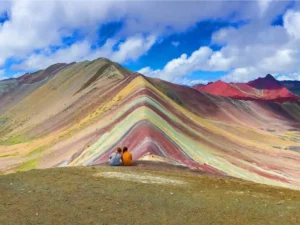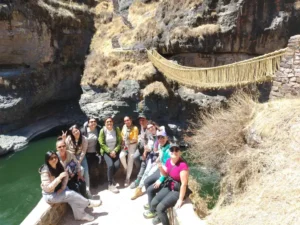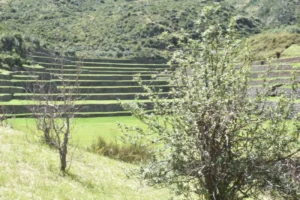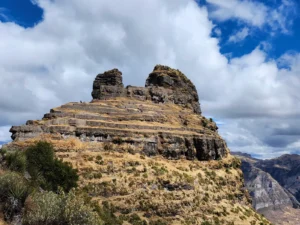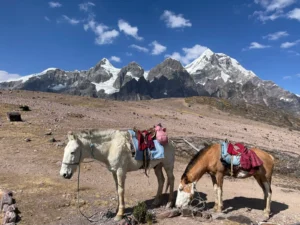What is Ollantaytambo? All about the living Inca town of the Sacred Valley
Ollantaytambo is much more than just a tourist destination. It is a place full of energy, history and culture that has endured for centuries. Located in the famous Sacred Valley of the Incas, this town is known as the last inhabited Inca city and one of the most important archaeological jewels of Peru.
In this article we will tell you what Ollantaytambo is, why it is so important, what you can do there, and why you should include it in your trip to Cusco or on your way to Machu Picchu.
Contents
Where is Ollantaytambo located?
Ollantaytambo is located 72 km from the city of Cusco, in the province of Urubamba. It is located at an altitude of approximately 2,792 meters above sea level, surrounded by mountains, rivers and impressive nature.
In addition to its historical importance, Ollantaytambo is also a key point on the route to Machu Picchu. Machu Picchuas one of the sections of the famous Inca Trail starts from here. Inca Trail and it is also the last train station before reaching Aguas Calientes.
Ollantaytambo: a living Inca city
This place is special because it is not an abandoned Inca city, but is still inhabited by local families living in houses built on Inca foundations. The cobblestone streets, the water channels that still flow, and the original urban layout have remained almost intact for more than 500 years.
Walking through Ollantaytambo is like traveling back in time: you can see how the Incas organized their cities, how they managed the water, how they took advantage of the geography to protect themselves and produce food.



The archaeological complex of Ollantaytambo
Undoubtedly, what impresses visitors most is the archaeological site that stands next to the town. Here you will find a set of terraces, temples, walls and viewpoints, all built with the most advanced Inca engineering.
Temple of the Sun
A monumental structure made of huge blocks of pink stone, precisely fitted together. Many experts believe that this temple was left unfinished after the arrival of the Spaniards, which makes it a fascinating mystery.

Agricultural terraces
Designed for cultivation and protection against landslides, these terraces are a clear example of Inca agricultural and architectural knowledge. Climbing them is an incredible experience, with panoramic views of the valley.

Ceremonial fountains
In the lower part of the site there are a series of canals and fountains that functioned as sacred spaces for water-related rituals. One of the best known is the “Baño de la Ñusta”, a place of spiritual purification.

Ollantaytambo in Inca and Colonial History
Ollantaytambo was not only an agricultural and ceremonial center, it was also a strategic fortress. In 1536, during the Inca resistance against the conquistadors, Manco Inca Yupanqui took refuge here and led one of the few military victories against the Spanish.
Using irrigation canals, he managed to flood part of the valley and stop the enemy advance. However, he later had to retreat into the jungle, founding Vilcabamba, the last bastion of the Inca empire.
This warrior past gives Ollantaytambo a very powerful symbolic value: it represents the struggle for freedom and Andean identity.
What to do in Ollantaytambo today?
There are many activities for all types of travelers. Here are some recommendations:
1. Visit the archaeological ruins
It is the main attraction. It is recommended to go with a guide to better understand its history. The Cusco tourist ticket includes admission.
2. Climbing Pinkuylluna Hill
On the other side of the village there is a path that leads to ancient Inca storehouses (colcas). The hike is free and offers a spectacular view of the main ruins.
3. Strolling through the Inca streets
The Qosqo Ayllu neighborhood is perfect for a leisurely walk to admire the original Inca walls that are still used as part of modern houses.
4. Visit the handicraft market
Here you can find textiles, ceramics, jewelry and other products handmade by local communities.
5. Taste the local food
There are restaurants with traditional Andean food, as well as cafes and bakeries overlooking the river.
6. Taking the train to Machu Picchu
From the Ollantaytambo train station, services depart to Aguas Calientes, the gateway to Machu Picchu, an unforgettable experience!
Tips for your visit to Ollantaytambo
- Wear comfortable shoes for walking on cobblestone roads.
- Wear sunscreen and a hat, especially if you visit during the day.
- Bring water and something warm: although it may be hot, the weather changes quickly.
- Arrive early to avoid the crowds, especially if you are visiting the archaeological site.
Why visit Ollantaytambo?
Because it is one of the few places in the world where you can:
- See how the Incas lived
- Visiting original ruins that have not been completely reconstructed
- To be in contact with a living community that maintains its customs.
- Enjoy a perfect blend of history, culture and nature.
Ollantaytambo is an essential stop on any trip to Cusco or the Sacred Valley. It is not just a destination: it is a profound and moving experience.
Ready to explore Ollantaytambo?
We can help you organize a complete tour of the Sacred Valley
Departures every day from Cusco
Includes transportation, bilingual guide, entrance fees and train to Machu Picchu if you wish
Contact us for more information or reservations.


